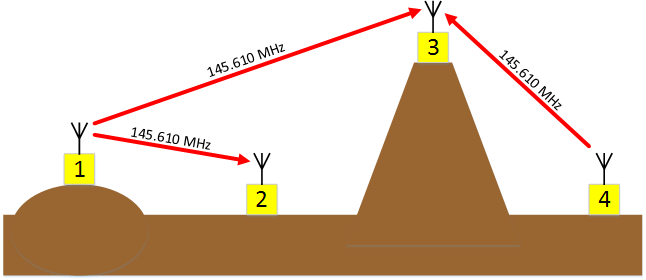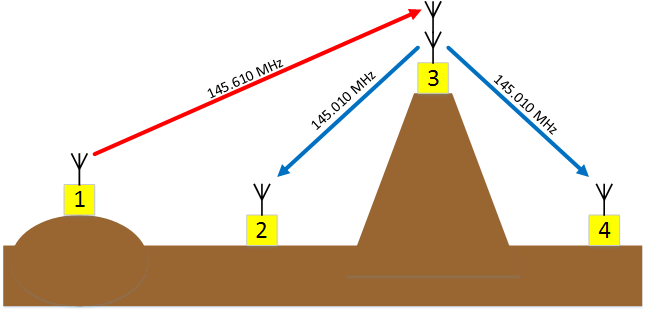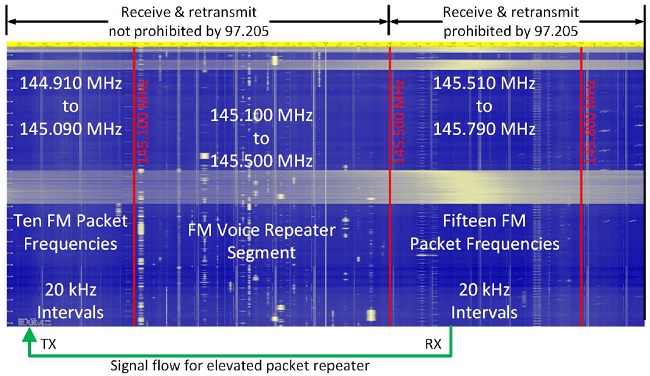Hidden Transmitter Syndrome
Anyone who can remember will recall the 2m packet frequencies were always a bit of a hot mess back in the day. Uncoordinated transmissions from various systems caused collisions the AX.25 protocol wasn’t able to handle. The CSMA collision management system built into AX.25 assumes all systems can hear all other systems. The diagram below shows why this isn’t possible in a real world RF scenario.

Station 4 cannot directly hear 1 and 2 and therefore may transmit when 3 goes silent. 1 or 2 can as well. This leads to the possibility of station 3 hearing multiple stations as once potentially ruining the packets for all. This was always packet radio’s Achilles’ heel.
The next figure makes station 3 a regional packet radio asset.

To ensure all client stations can hear each other, we configure station 3 to repeat in real time the audio heard from 1, 2 or 4. Now the AX.25 collision management system in stations 1, 2 and 4 can see when the channel is occupied and wait its turn. Thus configured, collisions are less likely if the 1984 experiment mentioned here is believable.
The question becomes if this is legal to do on the U.S. ham bands. Let’s first look at rules for repeaters.
Part 97.205(b)
From https://www.law.cornell.edu/cfr/text/47/97.205
(b) A repeater may receive and retransmit only on the 10 m and shorter wavelength frequency bands except the 28.0-29.5 MHz, 50.0-51.0 MHz, 144.0-144.5 MHz, 145.5-146.0 MHz, 222.00-222.15 MHz, 431.0-433.0 MHz, and 435.0-438.0 MHz segments.
Emphasis added.
Both 6m and 2m have 1 MHz of their 4 MHz repeater free.
- One segment between 50.0 to 51.0 MHz for the 6m band,
- Two segments between 144.0 to 144.5 and 145.5 to 146.0 MHz for the 2m band.
One can only wonder what was on the minds of the regulators to design these restrictions. To understand what the practical implication for FM packet radio on 6 and 2m, let’s see what older documentation has to say.
FM Duplex on 6m A-OK
The ARRL band plan has within it the notion of repeater style split frequencies for digital use…

One of the local frequency coordinating organizations for Virginia has this to say about duplex 6m packet…

They go a step further with several more digital repeater pair suggestions with 1 MHz splits.
So it seems the ARRL and SERA both support the notion for 6m duplex repeater packet radio.
FM Duplex on 2m = ?
Referring to the ARRL band plan once again for 2m we find this…

Unlike with 6m, no word on FM digital inputs/outputs. Here is what SERA says about FM packet…

Long story short, the first ten frequencies are where 97.205 says receive and retransmit are allowed. The remaining frequencies starting at 145.5 MHz are where receive and retransmit are not allowed.
Is this the reason documents from packet’s heyday didn’t specify duplex packet frequencies for 2m, but did for 6m? Hard to tell, but the difference between the two bands on the topic of duplex packet is obvious.
Where is 2m packet activity today?

The figure above shows a spiffy 24 hour continuous spectrogram made by a friend. I added notations for discussion. There is quite a bit of packet activity from 145.5 to 145.73 MHz. There is relatively little from 144.9 to 145.1 MHz.
It is my current belief I can setup a 2m digital repeater listening on the receive and retransmit and have it transmit on the lower segment as shown by the green line. Sometimes its hard to tell how specific a rule is. With that in mind I have sent a letter to Laura Smith asking for guidance on my goal to put a duplex 2m repeater on the air.
In the meantime experiments will continue using the above split frequencies.